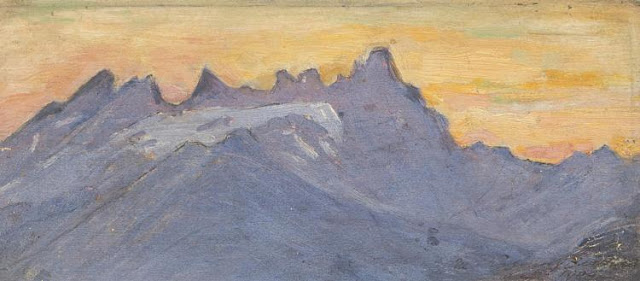VINTAGE POSTCARD 1955
Hvannadalshnjúkur (2,109.6 m - 6,921 ft)
Iceland
The volcano
Hvannadalshnjúkur (2,109.6 m - 6,921 ft) (pronounced KWANNA-dalsh-nyooker) is the highest peak in Iceland. Prior to 2005, it had been stated to be 2,119m but an official survey in 2005 revised this. It is actually the highest point on a crater rim of the volcano, Oræfajökull, located in extreme southeast Iceland only a few kilometers from the Atlantic Ocean. The volcano itself is massive, the largest post-glacial volcano in Iceland and, according to my research, only exceeded in mass by Etna as far as European volcanoes go. But this fact pales in comparison when you consider that Oræfajökull is but a small part of the massive glacier, Vatnajökull.Vatnajökull (meaning Lake Glacier, named after sub-glacial lakes under its center) is the largest glacier in Iceland and the largest glacial ice cap in Europe. At approximately 8500 square kilometers, it is larger than all of continental Europe's glaciers put together. This glacier takes up 1/12 of the country of Iceland and contains approximately 3300 cubic kilometers of ice. The average thickness of the glacier is 400 meters with the greatest thickness being over 1100 meters. It is interesting that scientists believe it was not formed during the last great Ice Age but during a cold period about 2500 years ago.
Vatnajökull has had five recorded eruptions with the latest three coming in 1996, 1998 and most recently in 2004. The 1996 eruption caused large floods taking out bridges and cutting off eastern and western Iceland from each other for a time. Oræfajökull has had two recorded eruptions in 1362 and 1727. The 1362 eruption was the greatest tephra fall in Icelandic history and caused the area's abandonment (the name means something like "glacier wasteland").
Hvannadalshnukur sits adjacent to Skaftafell National Park. Created in 1967, it covers 1700 square kilometers and lies on the west side of the peak between three of Vatnajökull's 46 outlet glaciers (Skeiðararjökull to the west, Morsarjökull to the north and Skaftafellsjökull to the east). To the immediate north of Skaftafell is a finger of land with amazing hikes and sites (see section below for details or click on the link in this paragraph). Skaftafell itself has worthy climbs of both technical rock and glacier and is an oasis of color and life in an area of southeastern Iceland that is so close to a massive drainage of the giant glacier where a huge amount of flat stream-filled sand dominates the coast. Skaftafell enjoys better weather and more sunshine hours than anywhere else in southeastern Iceland as it is protected from wind and rain by the volcano.
Climbing
The first ascent of Hvannadalshnukur was on August 17, 1891 when a British man named Frederick W. W. Howell was guided up by locals Pall Jonsson and Thorlakur Thorlaksson.
Vintage postcards
Postcards became popular at the turn of the 20th century, especially for sending short messages to friends and relatives. They were collected right from the start, and are still sought after today by collectors of pop culture, photography, advertising, wartime memorabilia, local history, and many other categories.Postcards were an international craze, published all over the world. The Detroit Publishing Co. and Teich & Co. were two of the major publishers in the U.S, and sometimes individuals printed their own postcards as well. Yvon were the most famous in France. Many individual or anonymous publishers did exist around the world and especially in Africa and Asia (Japan, Thailand, Nepal, China, Java) between 1920 and 1955. These photographer were mostly local notables, soldiers, official guides belonging to the colonial armies (british french, belgium...) who sometimes had rather sophisticated equipment and readily produced colored photograms or explorers, navigators, climbers (Vittorio Sella and the Archiduke of Abruzzi future king of Italy remains the most famous of them).
There are many types of collectible vintage postcards.
Hold-to-light postcards were made with tissue paper surrounded by two pieces of regular paper, so light would shine through. Fold-out postcards, popular in the 1950s, had multiple postcards attached in a long strip. Real photograph postcards (RPPCs) are photographs with a postcard backing.
Novelty postcards were made using wood, aluminum, copper, and cork. Silk postcards–often embroidered over a printed image–were wrapped around cardboard and sent in see-through glassine paper envelopes; they were especially popular during World War I.
In the 1930s and 1940s, postcards were printed on brightly colored paper designed to look like linen.
Most vintage postcard collectors focus on themes, like Christmas, Halloween, portraits of movie stars, European royalty and U.S. presidents, wartime imagery, and photos of natural disasters or natural wonders. Not to mention cards featuring colorful pictures by famous artists like Alphonse Mucha, Harrison Fisher, Ellen Clapsaddle, and Frances Brundage.

















